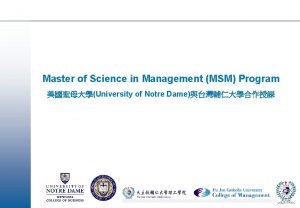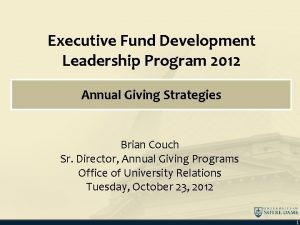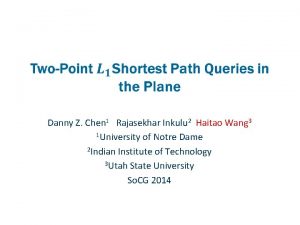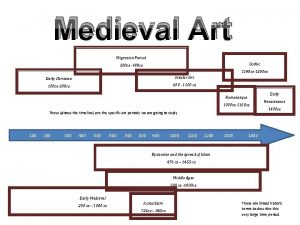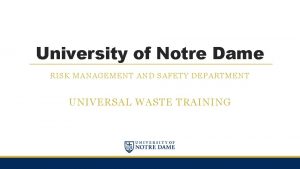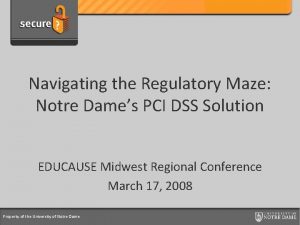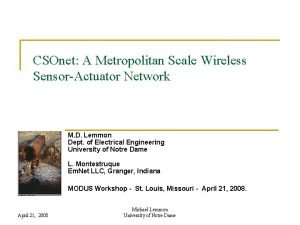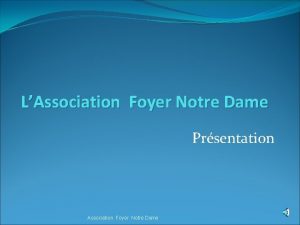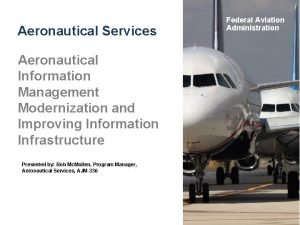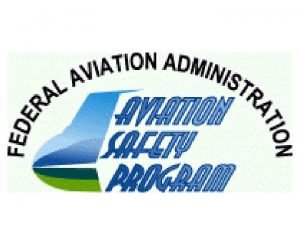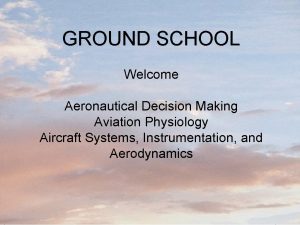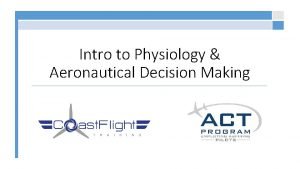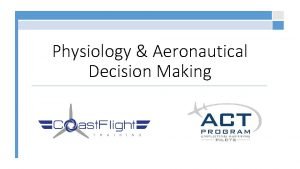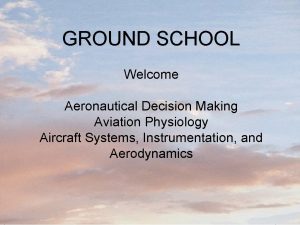Aeronautical Decision Making Written for the Notre Dame

























- Slides: 25

Aeronautical Decision Making Written for the Notre Dame Pilot Initiative By the Pilots of the University of Notre Dame “Teaching the Science, Inspiring the Art, Producing Aviation Candidates!”

Quote “Any pilot who does not privately consider himself the best in the game is in the wrong game. ” –Flying Magazine

Roadmap ñHazardous Attitudes ñCritical Flight Phases ñGA Accident Profiles ñPersonal Testimony

Lesson Plan ñWill learn the hazardous attitudes and their antidotes ñWill be able to interpret hazardous situations, develop mitigating actions, and implement ORM into the decision making process ñWill know the most critical phases of flight

Definitions ñADM is a systematic approach to the mental process used by pilots to consistently determine the best course of action in response to a given set of circumstances. ñAttitude is a personal motivational predisposition to respond to persons, situations, or events in a given manner § It can be modified through training.

Hazardous Attitudes

Critical Phases

Percentage of General Aviation Accidents Takeoff and Landing comprise 50% of accidents in only 3% of the time

How Does It Happen? ñTaxiing into buildings, a/c, & fuel trucks ñTaking Off Over Gross Weight ñClipping Trees / Power Lines on Takeoff ñEngine Failure on T/O ñFuel Starvation ñMidair Collision ñControlled Flight Into Terrain (CFIT) ñStall / Spin on Base to Final Turn ñLoss of Control in Crosswind Landing ñDropping it in From 20 feet

Single Pilot Resource Management ñSRM § “the art and science of managing all the resources (both onboard the aircraft and from outside sources) available to a single pilot (prior to and during flight) to ensure that the successful outcome of the flight is never in doubt. ” ñ SRM includes the concepts of § § § aeronautical decision making risk management task management automation management controlled flight into terrain awareness situational awareness

ñHow to apply? SRM § 5 P’s -The plan - planning, weather, route, fuel, publications, ATC reroutes/delays. -The plane - mechanical status, database currency, automation status, backup systems. -The pilot - illness, medication, stress, alcohol, fatigue, eating (IMSAFE). -The passengers - pilot or non-pilot, experienced or inexperienced, nervous or calm, etc. -The programming - GPS, autopilot, PFD/MFD, possible reroutes requiring reprogramming.

Risk Management ñDefinition: § Risk management is a decision making process designed to identify hazards systematically, assess the degree of risk, and determine the best course of action. ñHow to assess?

Risk Management ñHow to assess? § PAVE -Pilot-In-Command—general health, physical/mental/emotional state: proficiency, currency. -Aircraft—airworthiness, equipment, performance capability. -en. Vironment—weather hazards, terrain, airports/runways to be used, conditions. -External pressures—meetings, people waiting at destination, etc. § Personal Minimums §IMSAFE

Situational Awareness ñSA: § The accurate perception and understanding of all the factors and conditions within the four fundamental risk elements (pilot, aircraft, environment, external pressures) that affect safety before, during, and after the flight. ñSome elements of SA § Inside the aircraft—the status of aircraft systems, pilot, and passengers. § Outside the aircraft—awareness of the environmental conditions of the flight, such as spatial orientation of the aircraft and its relationship to terrain, traffic, weather, and airspace.

CFIT Awareness ñWhat is CFIT? § A situation in which an airworthy aircraft is flown, under the control of a qualified pilot, into terrain with inadequate awareness on the part of the pilot of the impending collision.

CFIT Awareness ñWhat are some causes of CFIT? § Lack of pilot currency. § Loss of situational awareness. § Pilot distractions and breakdown of SRM. § Failure to comply with minimum safe altitudes. § Breakdown in effective aeronautical decision making. § Insufficient planning especially for the descent and arrival segments.

CFIT Awareness ñHow can one avoid CFIT? § Maintain situational awareness at all times. § Adhere to safe takeoff and departure procedures. § Familiarize yourself with surrounding terrain features and obstacles. § Adhere to published routes and minimum altitudes. § Fly a stabilized approach. § Understand ATC clearances and instructions. § Don’t become complacent.

ADM ñWhat makes up ADM? § Risk management § situational awareness § single-pilot resource management. ñWhat is the decision making process?

Decision Making ñTwo models (from the FAA) § 3 P’s § DECIDE ñAnother model (from the Air Force) § OODA

Decision Making ñ 3 P’s § Perceives—the given set of circumstances for a flight; identify hazards in each risk category. § Processes—by evaluating the impact of those circumstances on flight safety; what can hurt you. § Performs—by implementing the best course of action; change the situation in your favor.

Decision Making ñDECIDE § § § Detect a change needing attention. Estimate the need to counter or react to a change. Choose the most desirable outcome for the flight. Identify actions to successfully control the change. Do something to adapt to the change. Evaluate the effect of the action countering the change. ñOODA § Observe § Orient § Decide § Act

Task Management ñDefinition: § Task management is the process by which pilots manage the many concurrent tasks that must be performed to safely and efficiently fly a modern aircraft. ñ What happens when information flow exceeds a person’s ability to mentally process and act on information? § When a pilot becomes task-saturated, there is no awareness of input from various sources, so decisions might be made with incomplete information and the possibility of error increases.

Task Management ñWhat are several options that a pilot can employ to decrease workload and avoid becoming overloaded? § Stop, think, slow down, and prioritize. Tasks such as locating an item on a chart or setting a radio frequency may be delegated to another pilot or passenger. An autopilot, if available, may be used. ATC may be enlisted to provide assistance.

Common Mistakes of Private Pilots ñUnfamiliarity with POH & installed equipment § Especially Audio Panel & GPS ñAirplane out of trim ñPoor airspeed control / No target airspeeds ñ“Jockeying” power esp. w/ a constant speed prop ñLack of a defined crosswind procedure—slip or kick straight method? § Inability to execute either procedure ñFixation with radio calls in the traffic pattern ñSetting the horizon bar on the attitude gyro on the ground § The takeoff checklist says “flight instruments-check” § There are only 2 of them to set—DG & altimeter ñ VFR goal: Be able to fly the aircraft hands-off during most flight regimes

Sources ñAdvisory Circular 60 -22, Aeronautical Decision Making, FAA ñPrivate Pilot Manual, Jeppesen ñWeather Flying, Robert Buck ñ“Common Mistakes, ” John Friel
 Cathédrale notre-dame-de-l'assomption de naples
Cathédrale notre-dame-de-l'assomption de naples Notre dame leeds moodle
Notre dame leeds moodle Notre dame msm program
Notre dame msm program Collège notre dame guingamp
Collège notre dame guingamp Notre dame des sablons
Notre dame des sablons Notre dame sorin society
Notre dame sorin society Ron kraemer notre dame
Ron kraemer notre dame Coca-cola sponsorship proposal
Coca-cola sponsorship proposal Romanesque art
Romanesque art Acct20100
Acct20100 Avignoni pieta
Avignoni pieta Fatima 2
Fatima 2 Notre dame high school belmont
Notre dame high school belmont Notre-dame de santa cruz
Notre-dame de santa cruz Danny chen notre dame
Danny chen notre dame What is the purpose of a flying buttress?
What is the purpose of a flying buttress? Issalink
Issalink Nous te saluons ô toi notre dame
Nous te saluons ô toi notre dame Notre dame de sion istanbul
Notre dame de sion istanbul Risk management notre dame
Risk management notre dame Vpn notre dame
Vpn notre dame How to upload photos on google
How to upload photos on google 1300 notre dame
1300 notre dame Michael lemmon notre dame
Michael lemmon notre dame Inside nd gmail
Inside nd gmail Nd army rotc
Nd army rotc


